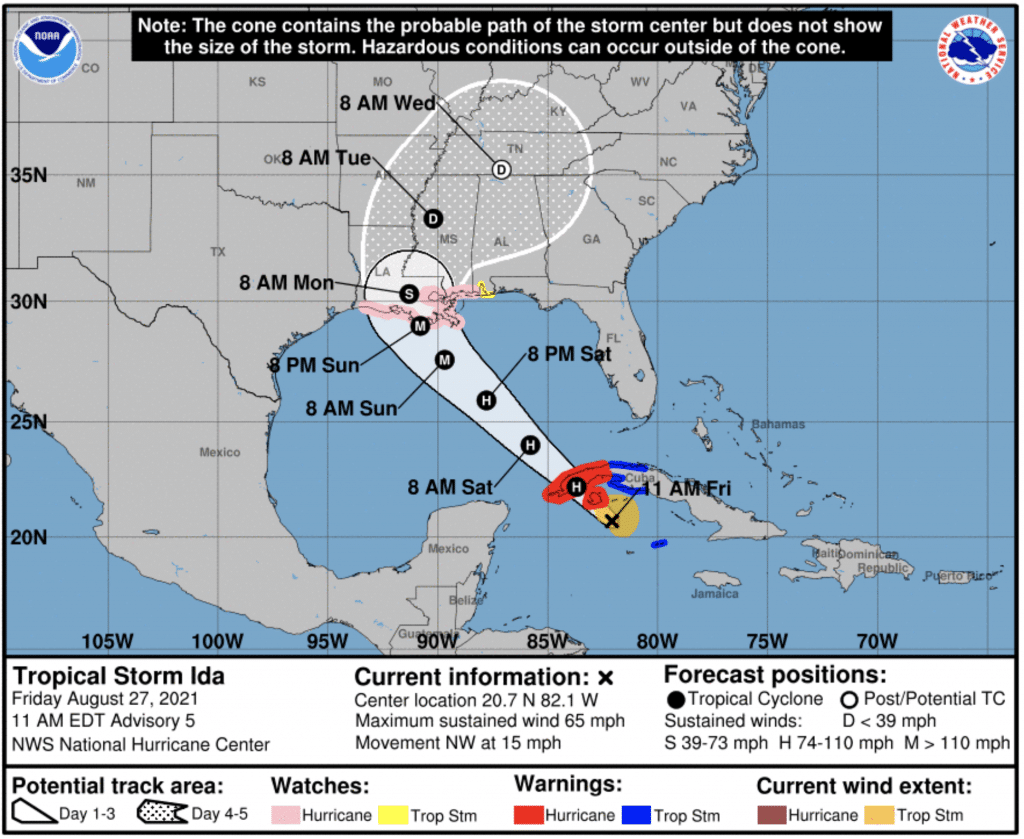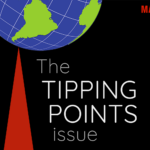Yes, the IPCC report was bad. But we can still salvage a livable planet.
By John Morales | August 27, 2021

Lake Charles may be hit again.
The National Hurricane Center’s forecast track for soon-to-be Hurricane Ida includes the possibility of a direct hit to southwest Louisiana. Lake Charles was struck by hurricanes Laura and Delta in 2020, with devastating consequences. Then this spring, a 15-inch deluge led to more flooding destruction and the displacement of several hundred families. The region has yet to recover. The resiliency and endurance of residents and institutions in Lake Charles is being pushed to the limit.
What’s happening in Louisiana is a symptom of the fast-changing climate. A warmer atmosphere leads to rain falling at unprecedented rates. Warmer seawater leads to the rapid intensification of hurricanes. And when they hit, the storm surge is deeper and penetrates further inland because of sea level rise. The planetary warming that includes warming in the air and ocean leads to melting ice in the Arctic, Greenland, and Antarctica, and increasing amounts of water vapor in the atmosphere. Increasing global average temperatures mean rising sea levels, more intense precipitation, and more severe droughts. The global average temperature is already 1.26 degrees Celsius (2.27 degrees Fahrenheit) higher than 1850, and nearly half of this increase (0.6 degrees Celsius or 1 degree Fahrenheit) has happened since the year 2000.
Climate-fueled extreme weather events are trending stronger, with shorter return-periods— meaning that what was once considered a one-in-50-year event can happen two or three times in a generation. This summer’s unprecedented heat in the Pacific Northwest, deepening drought and fires in the West, and extreme rain in the Midwest are all consistent with the predictions of what was to be expected in a warmer world. Such frequent disasters can lead to economic problems and societal challenges that can set a community on a path to ruin and an eventual exodus. While many fail to acknowledge it, there is a limit to resiliency.
Examples of places where it’s becoming difficult or impossible to adapt to the changing climate are now common. Central American subsistence farmers are struggling to feed their families due to a hyperactive cycle of drought and floods, forcing them to become climate refugees. Californians live in increasing fear of facing a raging wildfire and can no longer find or afford home insurance. Puerto Ricans cannot fathom facing another major hurricane like María in the next few years, instead of the 200-year return-period for such a catastrophic borderline-Category-5 event that the 20th-century climate would have dictated.
It’s bad already—the changing climate is a crisis. And it can get worse. Unless we stop it from getting worse.
Admittedly, this may look like an increasingly difficult process, given the latest news from the front lines of climate change. The Intergovernmental Panel on Climate Change (IPCC) released the first of three installments of the Sixth Assessment Report earlier this month. This first part of the new report updated the current scientific understanding of climate change; the big story is the growing confidence in the link between carbon dioxide in the atmosphere, rising global temperatures, and accelerating climate impacts. This is supported by updated climate models that provide more detailed projections about possible future conditions which—and this is crucial—depend on the choices humans make about carbon emissions.
The new report states confidently that the trend toward more weather extremes is caused by excess carbon dioxide in the atmosphere, and that these trends are highly likely to continue until carbon dioxide emissions are reduced to zero.
The warming will continue until carbon dioxide pollution stops. The more additional carbon dioxide we add to the atmosphere, the more warming we will get in the future. So the IPCC report spends a lot of time looking at what cuts in our global carbon dioxide emissions would be needed to keep temperatures from rising more than 1.5 degrees Celsius (2.7 degrees Fahrenheit) above pre-industrial levels. In the Paris Climate Agreement, countries around the world agreed to take primary steps to limit warming to 2 degrees Celsius (3.6 degrees Fahrenheit), but also take additional steps to limit warming to 1.5 degrees Celsius. Limiting warming to 1.5 degrees would decrease the risks of food and water insecurity and potentially save global coral reefs from complete devastation.
Meeting the 1.5-degree target is not impossible, but it is becoming increasingly difficult. Changes that were predicted in prior reports have come to pass and scientists have very high confidence that warming trends will continue. The report also emphasizes the risks of compound extremes, joint occurrences of potentially damaging events that become more likely at higher levels of warming—like what is happening in Louisiana.
There is a lot of bad news in the report. On the other hand, we know what is coming and can prepare for it. We also have an increasing number of countries—significantly, that now includes the United States—as well as states, cities, businesses and institutions that have made commitments to reduce net carbon emissions to zero by 2050. Achieving these goals is possible, especially as wind turbines, solar cells, and electric batteries get better and less expensive. (Achieving these goals will also have an economic boost by creating more clean-energy jobs, reducing health care costs, and avoiding the cost of recovering from even worse climate-related disasters.)
Most important, we must remember that the world doesn’t end if we go past 1.5 degrees. Simply hitting 1.6 degrees Celsius for the first time will not trigger the beginning of the end of days. However, every additional tenth of a degree makes extreme weather, sea level rise, and climate impacts on nature and people worse.
That is why it is so critical that we all look holistically at the climate crisis and realize that if we act, we can still salvage a livable planet. Crisis management depends on remaining calm and working the problem.
Don’t panic!
Don’t succumb to doomists that tell you that there is no way out of this. Yes, additional global warming is baked into the system. Earth will still be a difficult place to live even at 1.3 degrees Celsius over pre-industrial levels—just ask folks in Guatemala, California, or Louisiana. But a one-degree warmer planet is a heckuva lot better than a two-, three-, or four-degree hotter planet.
First things first—we need to slow down the warming. Beyond reducing you and your community’s carbon footprint, this will require a systemic change that can only be achieved at institutional levels and across borders. Government action and collaboration is unequivocally needed, and you must advocate for and demand it with more zeal than your passion to be vegan or to compost. Collective and systemic actions on climate are orders of magnitude more powerful than individual actions.
Also, recognize when pragmatism is called for. Think hard before criticizing it, because we all need to pull in the same direction right now. Aim for smaller wins in the third quarter instead of a Hail Mary in the last seconds of the fourth. Don’t let the perfect be the enemy of the good.
Beyond all, don’t let fear of the future paralyze you in the present. To borrow from climate scientist Michael Mann’s shrewd use of the famous Franklin Delano Roosevelt quote in The New Climate War—“The only thing we have to fear is … fear itself—nameless, unreasoning, unjustified terror which paralyzes needed efforts to convert retreat into advance.” There are forces, many shadowy or nameless, that want nothing more than for you to feel paralyzed in the face of carbon pollution’s siege on the planet. They are trying everything—deflection, diversion, division, and doomism—to get you to stop reasoning.
Keep your eye on the goal to halt and reverse the warming. We will get there. But for now, we need to turn our retreat into an advance by slowing down the present rate of warming. The hill is there to be taken.
Together, we make the world safer.
The Bulletin elevates expert voices above the noise. But as an independent nonprofit organization, our operations depend on the support of readers like you. Help us continue to deliver quality journalism that holds leaders accountable. Your support of our work at any level is important. In return, we promise our coverage will be understandable, influential, vigilant, solution-oriented, and fair-minded. Together we can make a difference.
Keywords: IPCC, Paris Agreement, climate change, climate crisis, drought, emissions, global warming, hurricane
Topics: Climate Change, Columnists, Opinion
















It would be nice if a few more people would recognise – and allow – interventions such as marine cloud brightening to cool the planet. That is what other meteorologists have said. That way the additional CO2 and methane emissions from e.g. thawing, drying Siberian permafrost might not need to be so much. The problem is that people calling themselves environmentalists succeed in blocking each and every attempt to get even the smallest funding for such research – e.g. how to provide cooling in such a way that maximises a return to previous rainfall patterns. They do it to prevent… Read more »
We have to ban dirty coal, ban tar sands of Utah and Canada, and the Line 1 pipeline. At present, relying on capitalist ideas that are not viable, like the best carbon capture at 6x cost, invites a certain private/public partnership where CEO’s earn mid 6 figure incomes for ideas that are basically business welfare, socialism or what you want to call it, where the idea is to make personal money, and not worry about a viable product. Many military hardware adventures end up in this cycle. Let’s not remake this model in the existential threat category. If you are… Read more »